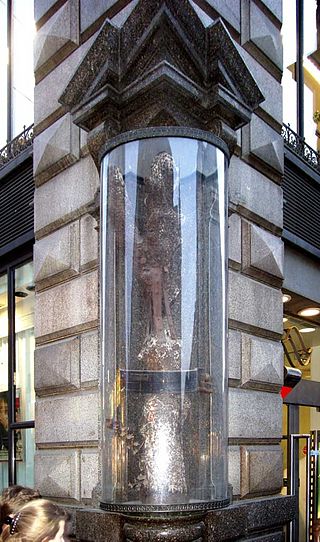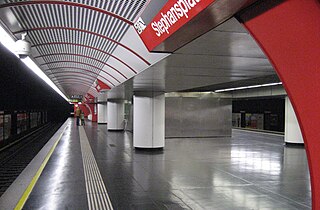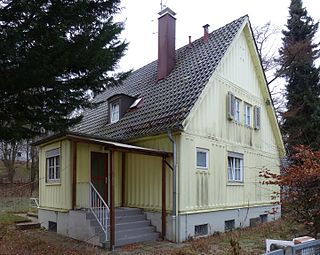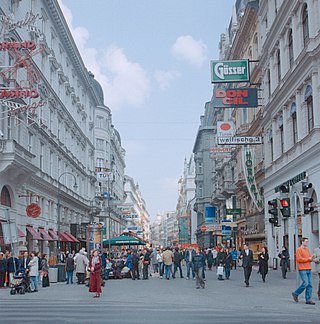
The Vienna Ring Road is a 5.3 km circular grand boulevard that serves as a ring road around the historic Innere Stadt district of Vienna, Austria. The road is located on sites where medieval city fortifications once stood, including high walls and the broad open field ramparts (glacis), criss-crossed by paths that lay before them.

The Graben is one of the most famous squares in Vienna's first district, the city center. It begins at Stock-im-Eisen-Platz next to the Palais Equitable, and ends at the junction of Kohlmarkt and Tuchlauben. Another street in the first district is called Tiefer Graben. It is crossed by Wipplinger Straße by means of the Hohe Brücke, a bridge about 10 meters (33 ft) above street level.

The Stoclet Palace is a mansion in Brussels, Belgium. It was designed by the Austrian architect Josef Hoffmann for the Belgian financier Adolphe Stoclet. Built between 1905 and 1911 in the Vienna Secession style, it is located at 279–281, avenue de Tervueren/Tervurenlaan, in the Woluwe-Saint-Pierre municipality of Brussels. Considered Hoffman's masterpiece, the residence is one of the 20th century's most refined and luxurious private houses.

Bayerischer Platz is a Berlin U-Bahn station on the U4 and the U7 lines. The station is located under the square of the same name in the centre of the Bayerisches Viertel neighbourhood in Schöneberg. The U4 station opened with the rest of the line on 1 December 1910 and is now a protected historic landmark; the U7 part of the station opened on 29 January 1971.

Heinrich-Heine-Straße is a Berlin U-Bahn station on the U8, located under the street of the same name in Mitte, and protected as an architectural landmark. The street and the station were called Neanderstraße until 1960.

The Stephansplatz is a square at the geographical centre of Vienna, Austria. It is named after its most prominent building, the Stephansdom, Vienna's cathedral and one of the tallest churches in the world. Before the 20th century, a row of houses separated Stephansplatz from Stock-im-Eisen-Platz, but since their destruction, the name Stephansplatz started to be used for the wider area covering both. To the west and south, respectively, run the exclusive shopping streets Graben and Kärntner Straße. Opposite the Stephansdom is the Haas-Haus, a piece of striking modern architecture by Hans Hollein. Although public opinion was originally skeptical about the combination of the mediaeval cathedral and the glass and steel building, it is now considered an example of how old and new architecture can mix harmoniously .

The Stock im Eisen is the midsection of a tree-trunk from the Middle Ages, a so-called nail-tree (Nagelbaum), into which hundreds of nails have been pounded for good luck over centuries. It is located in Vienna, Austria, in Stock-im-Eisen-Platz, now part of Stephansplatz, at the corner of the Graben and Kärntner Straße and is now behind glass on a corner of the Palais Equitable.

Friedrich Achleitner was an Austrian poet and architecture critic. As a member of the Wiener Gruppe, he wrote concrete poems and experimental literature. His magnum opus is a multi-volume documentation of 20th-century Austrian architecture. Written over several decades, Achleitner made a personal visit to each building described. He was a professor of the history and theory of architecture at the University of Applied Arts Vienna.

Joseph Emanuel Fischer von Erlach, also Fischer von Erlach the Younger was an Austrian architect of the Baroque, Rococo, and Baroque-Neoclassical.

Equitable Holdings, Inc. is an American financial services and insurance company that was founded in 1859 by Henry Baldwin Hyde. In 1991, French insurance firm AXA acquired majority control of The Equitable.

Karl Heinz is an Austrian architect. With two colleagues, as the firm Heinz & Mathoi & Streli, he built private homes in the alpine landscape of Tyrol, schools, offices and public buildings, among others.

Stephansplatz is an important destination and interchange station in the Vienna U-Bahn system. It is located under the Stephansplatz and is served by lines U1 and U3. It is located in the Innere Stadt district.

The Palais Albert Rothschild was a palatial residence in Vienna, Austria. It was one of five Palais Rothschild in the city that were owned by members of the Rothschild banking family of Austria, a branch of the international Rothschild family. It was located at Heugasse 26, in the 4th (Wieden) district of Vienna. Commissioned by Baron Albert von Rothschild, it was designed and built by the French architect Gabriel-Hippolyte Destailleur between 1876 and 1884, and demolished in 1954.

The Vienna Museum is a group of museums in Vienna consisting of the museums of the history of the city. In addition to the main building in Karlsplatz and the Hermesvilla, the group includes numerous specialised museums, musicians' residences and archaeological excavations.

The MAN steel house was a pre-fabricated building by MAN. A total of 230 units were built worldwide from 1948 to 1953.
The Palais des Beaux Arts is a residential and office building at Löwengasse 47-47A in Vienna's third district, Landstraße. The building has housed the embassies of the Republic of Lithuania and the Republic of Moldova since 1994. The building was erected between 1908 and 1909 by Anton and Josef Drexler, who also designed several houses on Rudolf-von-Alt-Platz and contributed other designs to the surrounding Weißgerberviertel quarter of the district. The building was originally built as home to Chic Parisien, a center for fashion.

The following outline is provided as an overview of and topical guide to Vienna:

The Cologne Cathedral quarter is the area immediately surrounding Cologne Cathedral in Cologne, North Rhine-Westphalia, Germany. When the Gothic cathedral was built, it was closely surrounded by houses and smaller churches. When the cathedral was completed in 1880 as a national symbol, it was freed from adjacent structures and stood isolated, unhampered by traffic. After the inner city was destroyed in World War II, it was rebuilt, with a pedestrian area connecting to the cathedral. In 1970, the Domplatte was constructed as a large concrete surface without steps around the cathedral, which became the location of major open-air events such as Carnival and pop concerts. The design of the cathedral surroundings has remained a challenge for urban planning.
Felix Gottfried Wehling was a German architect.


















